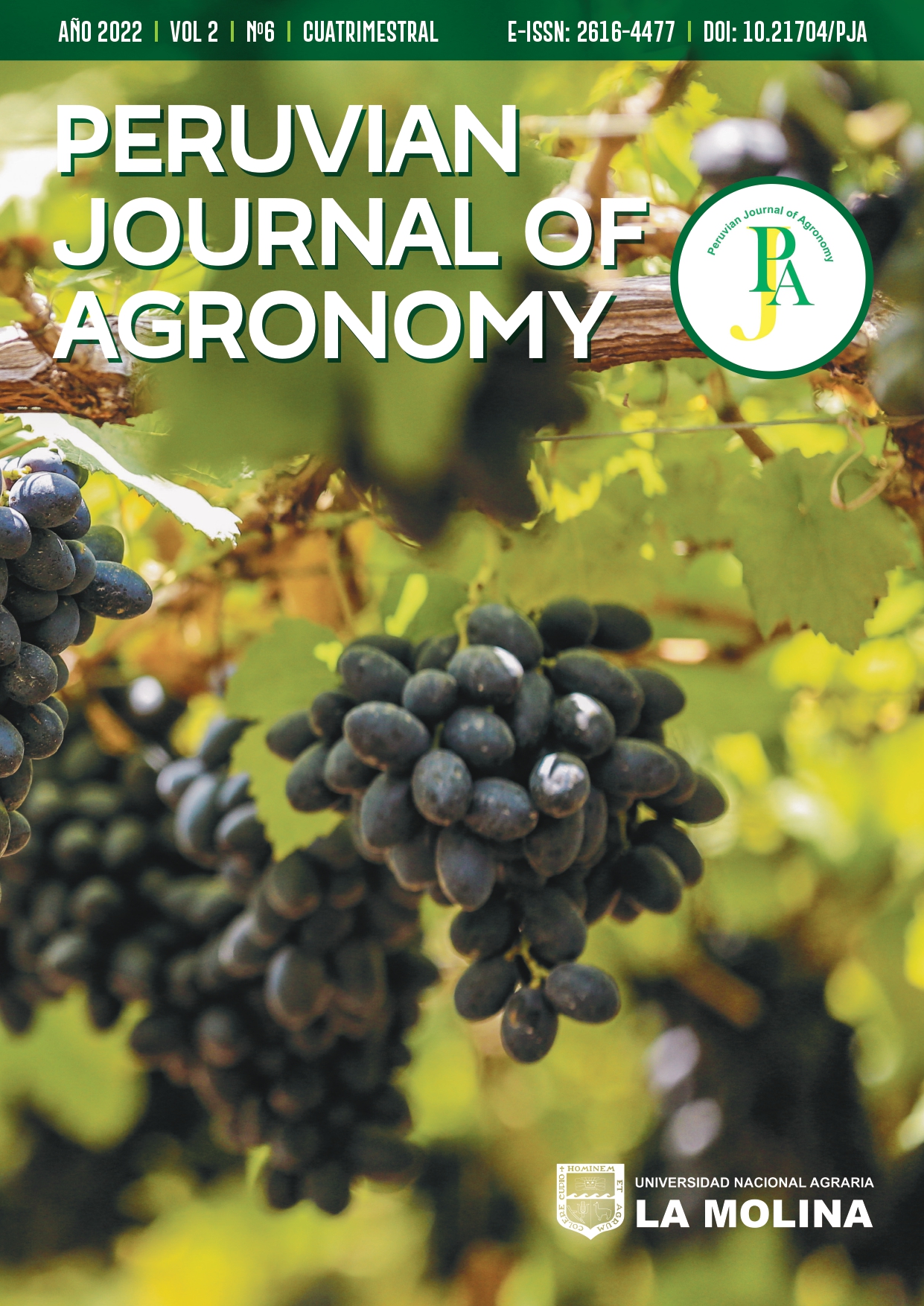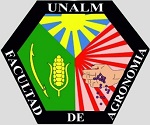Impacto de dos prácticas de labranza en determinadas propiedades del suelo, crecimiento y rendimiento del maíz en un Ultisol de Nigeria
DOI:
https://doi.org/10.21704/pja.v6i2.1933Palabras clave:
Labranza convencional, cultivo de maíz, arado, grada, ultisolResumen
Este estudio investigó el efecto de dos prácticas de labranza sobre el rendimiento y el crecimiento del maíz, y propiedades seleccionadas del suelo de un Ultisol del estado de Osun en Nigeria. Esto tuvo como objetivo seleccionar una práctica de labranza adecuada para el crecimiento de los cultivos y el mantenimiento del suelo. El estudio se dividió en dos parcelas experimentales durante la temporada de cultivo temprana y tardía en 2014. La primera parcela se desbrozó manualmente para tener labranza cero, mientras que la segunda parcela se aró dos veces y se rastrilló una vez para labranza convencional. Cada parcela tenía tres bloques (23.0 m x 2.5 m) con un callejón de 1.0 m entre bloques y 1.0 m dentro de las parcelas. Tres semillas del cultivo de prueba se colocaron a una distancia de 75 cm x 50 cm por montículo y cada parcela se desyerbó manualmente a intervalos de dos semanas hasta la cosecha. Las propiedades físicas y químicas del suelo seleccionadas y los parámetros de crecimiento de las plantas se recolectaron y determinaron utilizando el método estándar después de cada temporada de cultivo. Al final del experimento, tuvo los valores más altos de altura de planta y suelo en comparación con la labranza convencional. La labranza cero también tuvo valores químicos del suelo más altos en comparación con la labranza convencional. El rendimiento de grano mostró una diferencia significativa entre las prácticas de labranza. La labranza cero tuvo un mayor rendimiento (1.71 t/ha) en comparación con la labranza convencional (0.97 t/ha). El estudio concluyó que la labranza cero era una mejor alternativa para el crecimiento de los cultivos y el mantenimiento del suelo de un Ultisol.
Descargas
Referencias
Alam, Md. K., Islam, Md. M., Salahin, N., & Hasanuzzaman, M. (2014). Effect of Tillage Practices on Soil Properties and Crop Productivity in Wheat-Mungbean-Rice Cropping System under Subtropical Climatic Conditions. The Scientific World Journal, 2014, 1–15. https://doi.org/10.1155/2014/437283
Adedokun, A. S., Ogunyemi, O. I., & Lawal, B. A. (2018). Sustainable Agricultural Practices And Arable Farmers Productivity In Lagos State, Nigeria. Journal Of Sustainable Development In Africa, 20(2), 11–21.
Aikins, S., Afuakwa, J., & Owusu-Akuoko, O. (2012). Effect of Four Different Tillage Practices on Maize Performance under Rainfed Conditions. Agriculture and Biology Journal of North America, 3(1), 25–30. https://doi.org/10.5251/abjna.2012.3.1.25.30
Ali, A., Usman, M., & Adaikwu, A. O. (2018). Effect of Tillage Methods on Soil Properties, Growth and Yield of Maize (Zea mays L.) in Makurdi, Nigeria. International Journal of Science and Healthcare Research, 1, 8–6.
Basamba, T. A., Amézquita, E., Singh, B. R., & Rao, I. M. (2006). Effects of Tillage Systems on Soil Physical Properties, Root Distribution and Maize Yield on Colombian Acid-Savanna Oxisol. Acta Agriculturae Scandinavica, Section B - Plant Soil Science, 56(4), 255–262. https://doi.org/10.1080/09064710500297690
Bouyoucos, G. H. (1951). A Recalibration of the Hydrometer Method for Making the Mechanical Analysis. Agronomy Journal, 43, 434–438.
Cookson, W. R., Murphy, D. V., & Roper, M. M. (2008). Characterizing the relationships between soil organic matter components and microbial function and composition along a tillage disturbance gradient. Soil Biology and Biochemistry, 40(3), 763–777. https://doi.org/10.1016/j.soilbio.2007.10.011
Cooper, H. V., Sjögersten, S., Lark, R. M., Girkin, N. T., Vane, C. H., Calonego, J. C., & Mooney, S. J. (2021). Long‐term zero‐tillage enhances the protection of soil carbon in tropical agriculture. European Journal of Soil Science, 2021, 1–16. https://doi.org/10.1111/ejss.13111
Crittenden, S. J., Poot, N., Heinen, M., van Balen, D. J. M., & Pulleman, M. M. (2015). Soil physical quality in contrasting tillage systems in organic and conventional farming. Soil and Tillage Research, 154, 136–144. https://doi.org/10.1016/j.still.2015.06.018
Dorneles, E. P., Lisboa, B. B., Abichequer, A. D., Bissani, C. A., Meurer, E. J., & Vargas, L. K. (2015). Tillage, fertilization systems and chemical attributes of a Paleudult. Scientia Agricola, 72(2), 175–186. https://doi.org/10.1590/0103-9016-2013-0425
FAOSTAT. (2017). Available from: http://www.fao.org/faostat/en/#data/QC
Guan, D., Zhang, Y., Al-Kaisi, M. M., Wang, Q., Zhang, M., & Li, Z. (2015). Tillage practices effect on root distribution and water use efficiency of winter wheat under rain-fed condition in the North China Plain. Soil and Tillage Research, 146, 286–295. https://doi.org/10.1016/j.still.2014.09.016
Haddaway, N. R., Hedlund, K., Jackson, L. E., Kätterer, T., Lugato, E., Thomsen, I. K & Isberg, P. E. (2017). How does tillage intensity affect soil organic carbon? A systematic review. Environmental Evidence, 6(1), 30. https://doi.org/10.1186/s13750-017-0108-9
Hamza, M. A., & Anderson, W. K. (2005). Soil compaction in cropping systems. Soil and Tillage Research, 82(2), 121–145. https://doi.org/10.1016/j.still.2004.08.009
Lal, R. (1997). Long-term tillage and maize monoculture effects on a tropical Alfisol in western Nigeria. I. Crop yield and soil physical properties. Soil chemical properties. Soil and Tillage Research, 42(3), 161–174. https://doi.org/10.1016/S0167-1987(97)00006-8
Mathew, R. P., Feng, Y., Githinji, L., Ankumah, R., & Balkcom, K. S. (2012). Impact of No-Tillage and Conventional Tillage Systems on Soil Microbial Communities. Applied and Environmental Soil Science, 2012, 1–10. https://doi.org/10.1155/2012/548620
Mohanty, M., Painuli, D., Misra, A., & Ghosh, P. (2007). Soil quality effects of tillage and residue under rice–wheat cropping on a Vertisol in India. Soil and Tillage Research, 92(1–2), 243–250. https://doi.org/10.1016/j.still.2006.03.005
Omeke, J. O. (2017). Effect of tillage, rhizobium inoculation in maize-soybean based cropping systems and nitrogen fertilizer application on chemical fertility status of savanna Alfisol, Nigeria. Agro-Science, 15(3), 1–18. https://doi.org/10.4314/as.v15i3.4
Osunbitan, J. A., Oyedele, D. J., & Adekalu, K. O. (2005). Tillage effects on bulk density, hydraulic conductivity and strength of a loamy sand soil in southwestern Nigeria. Soil and Tillage Research, 82(1), 57–64. https://doi.org/10.1016/j.still.2004.05.007
Ram, H., Singh, R. K., Pal, G., Agarwal, D. K., & Kumar, R. (2018). Effect of tillage practices and genotypes on growth, seed yield and nutrient uptake in wheat (Triticum aestivum). Indian Journal of Agricultural Sciences, 88(11), 1765–1769.
Rasmussen, K. J. (1999). Impact of ploughless soil tillage on yield and soil quality: A Scandinavian review. Soil and Tillage Research, 53(1), 3–14. https://doi.org/10.1016/S0167-1987(99)00072-0
Rouf Shah, T., Prasad, K., & Kumar, P. (2016). Maize-A potential source of human nutrition and health: A review. Cogent Food and Agriculture, 2(1), 1166995. https://doi.org/10.1080/23311932.2016.1166995
Santpoort, R. (2020). The Drivers of Maize Area Expansion in Sub-Saharan Africa. How Policies to Boost Maize Production Overlook the Interests of Smallholder Farmers. Land, 9(3), 68. https://doi.org/10.3390/land9030068
Singh, G., Bhattacharyya, R., Das, T. K., Sharma, A. R., Ghosh, A., Das, S., & Jha, P. (2018). Crop rotation and residue management effects on soil enzyme activities, glomalin and aggregate stability under zero tillage in the Indo-Gangetic Plains. Soil and Tillage Research, 184, 291–300. https://doi.org/10.1016/j.still.2018.08.006
Soane, B. D., Ball, B. C., Arvidsson, J., Basch, G., Moreno, F., & Roger-Estrade, J. (2012). No-till in northern, western and south-western Europe: A review of problems and opportunities for crop production and the environment. Soil and Tillage Research, 118, 66–87. https://doi.org/10.1016/j.still.2011.10.015
Tarkalson, D. D., Hergert, G. W., & Cassman, K. G. (2006). Long-Term Effects of Tillage on Soil Chemical Properties and Grain Yields of a Dryland Winter Wheat-Sorghum/Corn-Fallow Rotation in the Great Plains. Agronomy Journal, 98(1), 26–33. https://doi.org/10.2134/agronj2004.0240
Thomas, G., Dalal, R., & Standley, J. (2007). No-till effects on organic matter, pH, cation exchange capacity and nutrient distribution in a Luvisol in the semi-arid subtropics. Soil and Tillage Research, 94(2), 295–304. https://doi.org/10.1016/j.still.2006.08.005
Walkley, A., & Black, I. A. (1934). An examination of the Degtjareff method for determining soil organic matter and a proposed modification of the chromic acid titration method. Soil Science, 37, 29–38.
Descargas
Publicado
Número
Sección
Licencia
Derechos de autor 2022 Oluwatosin Komolafe

Esta obra está bajo una licencia internacional Creative Commons Atribución 4.0.











